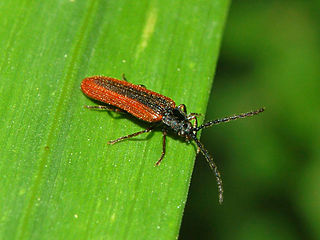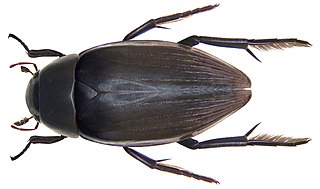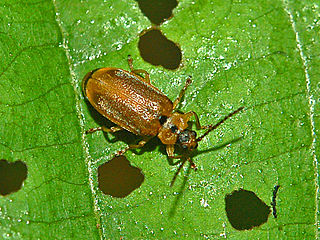
Trox is a genus of hide beetle in the subfamily Troginae.

Meloe is a genus of blister beetles commonly referred to as oil beetles. The name derives from their defensive strategy: when threatened by collectors or predators they release oily droplets of hemolymph from their joints. This fluid is bright orange and contains cantharidin, a poisonous chemical compound. Wiping the chemical on skin can cause blistering and painful swelling of the skin. This defensive strategy is not exclusive to this genus; all meloids possess and exude cantharidin upon threat.

Cantharis is a large genus of soldier beetles in the family Cantharidae with narrow and soft elytra.

Chrysolina is a large genus of leaf beetles in the subfamily Chrysomelinae. Most species are distributed in Europe, Asia and Africa with a small number of species inhabiting North America and introduced species in Australia.

Galeruca is a genus of leaf beetles in the subfamily Galerucinae. It is distributed in the Palaearctic and Nearctic realms. In Turkey, the genus is represented by 10 species.

The Omalisinae are a small subfamily of morphologically derived elaterid beetles. The Omalisinae were long considered an independent family in the deprecated family Cantharoidea, and later a family in the Elateroidea, but molecular phylogenies have demonstrated the morphological similarity of Omalisinae to other soft bodied beetles is a case of parallel evolution (homoplasy) of their soft bodies, rather than an apomorphy. Members of this beetle subfamily have been reported to have bioluminescent organs on the larvae, although no recent publications have confirmed this. Some recent evidence indicated they were the sister group to a clade comprising the families Rhagophthalmidae and Phengodidae, however a more comprehensive phylogenetic analysis based on genome sequences strongly supported the Omalisinae as being contained within the Elateridae.

Mylabris is a genus of beetles in the family Meloidae. It is endemic to the Palearctic realm. The species-rich genus Hycleus was historically confused with Mylabris and have their greatest diversity in the Afrotropics.

Hydrophilus is a genus of beetles in the family Hydrophilidae, the water scavenger beetles. There are 53 species in three subgenera in the genus: Hydrophilus, Dibolocelus, and Temnopterus.

Cheilotoma is a genus of beetles in the subfamily Cryptocephalinae of the leaf beetles family.

Galerucella is a genus of leaf beetles in the family Chrysomelidae described by George Robert Crotch in 1873. It is widely distributed but absent in the Neotropics. Some species feed on waterlilies and are used as biocontrol of introduced, invasive waterlilies. Galerucella tenella feed on strawberry plants.

Oreina is a genus of broad-shouldered leaf beetles belonging to the family Chrysomelidae, subfamily Chrysomelinae.

Gonocephalum is a genus of darkling beetles in the family Tenebrionidae.

Hycleus is a genus of blister beetle belonging to the Meloidae family found in Africa and Asia. The genus contains over 400 species, which historically have been confused with the genus Mylabris.

Mallosia, described by Étienne Mulsant in 1847, is a genus of longhorn beetles of the subfamily Lamiinae, tribe Saperdini. It is distributed in the Palearctic, from Greece to Caucasus and Iran.

Sphaeridium is a genus of beetles in the family Hydrophilidae, the water scavenger beetles. They occur in Europe, and some species have been introduced to North America.

Anisodactylus binotatus is a species of ground beetle native to Europe. It was discovered as being introduced to Canterbury, New Zealand in 1938. Anisodactylus binotatus is a species of Carabidae, also known as the ground beetle family. Although this species of beetle has no official recorded common names, literature from England refers to it as the common shortspur beetle.

Actenodia is a genus of blister beetles in the family Meloidae. The genus was named and described by Francis de Laporte de Castelnau in 1840.

Mycetochara is a genus of comb-clawed beetles in the family Tenebrionidae. There are at least 30 described species in Mycetochara.

Mylabris variabilis is a species of blister beetle belonging to the Meloidae family.



















